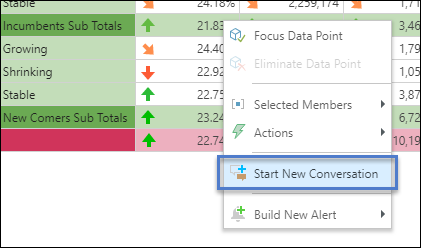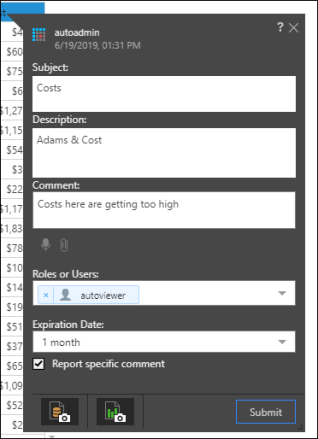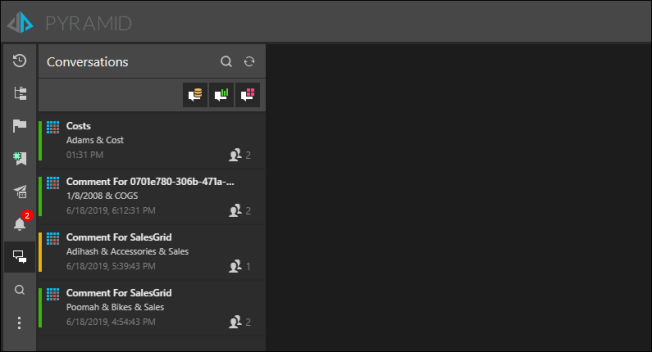Related Topics
Start or Show a Conversation
Data Discovery
To start a new conversation from a data discovery, right click on the relevant data point (cell or chart component), and click Start New Conversation from the context menu.
To show existing conversations, click the conversations icon.

Presentation
To start a new conversation at the cell level from a presentation, right click on the relevant data point (cell or chart component), and click Start New Conversation.
To start a new conversation at the presentation level, open the Presentation Menu and toggle Conversations on (red highlight). This will open the Conversations panel, which will display existing conversations; click the Start New Conversation icon (blue highlight) to create a new conversation.

New Conversation Panel
Start by adding a subject line and description, then write your comment. You can also record a voice message or attach a file.
Next, select which users or roles to include in the conversation, and then add an expiration date (select None if the conversation shouldn't expire).

Report-Specific Comments
Enable 'Report-specific comment' if the conversation should apply to the member or cell in the current data discovery only. In Present, you have the option to create Panel Specific Conversations. This is known as a Report Specific Conversation.
Disable 'Report-specific comment' to apply the conversation to the member or cell globally, across the current data model. In this scenario, the conversation may be opened from other data discoveries that contain the given member or cell, in both Discover and Present. This is known as a Global Conversation.
When viewing the Conversations panel, you can choose to show global conversations (for the current data model), or conversations specific to the current discovery only.
or Global Conversations.
Snapshots
Snapshots are used to save the query structure and results from the time the conversation was created. This means that even if the data discovery is changed, or the data is updated, conversation participants will be able to load the snapshot and see the results from the time the conversation was started.
Snapshots are enabled by default. If you don't want to save a snapshot, deselect them before submitting your comment.
Save Data Snapshot: store the results of the query at the time the conversation was started. When this option is selected, a discovery snapshot is also saved by default.
Save Discovery Snapshot: store the query structure at the time the conversation was started. It is possible to select this option without also saving a data snapshot
Click here to learn more about the New Conversation Panel, including report-specific comments and snapshots.
Viewer Conversations Feed
The Conversations Feed lists the conversations in which you're a participant. Simply click on a conversation to open it.
You can filter the Conversations Feed by three types of conversation: model conversations, discover-specific conversations, or present-specific conversations.

Conversation Actions
You can perform the following actions from an open conversation:
- Load Data Snapshot: open the original query (from the time that the conversation was started), with current results.
- Load Discover Snapshot: open the original query results stored at the time the snapshot was taken.
- Load Current Discover Report/ Present Dashboard: open the current data discovery or presentation to see the most recent data.
- Leave Conversation: this option is available only to users that are conversation participants, not roles.
- Refresh: click the refresh icon to refresh the conversation.
- Click on the user icon (blue arrow below) to view conversation participants.
- Write your comment in the text box, or record a message or attach a file.
Conversation Timeline
The conversation timeline groups comments in the conversation by time. The position of the circles on the timeline indicates periods with more activity. Comments are grouped depending on the duration of the conversation. For example, an older conversation may be grouped by days or weeks.
